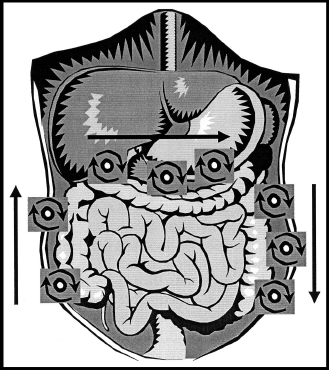4 Ways to Help Reduce Chronic Pain
Many of the patients we treat at Lokahi are here because of chronic illness, such as Irritable Bowel Syndrome (IBS), endometriosis, or Interstitial Cystitis (IC). Our physical therapy treatments help reduce pain and other symptoms by increasing blood flow to the affected ares, breaking up adhesions, and promoting healthy functioning of internal organs, but aside from physical therapy, if you have a chronic illness you may want to consider incorporating some additional lifestyle changes into your daily routine to help you get better and stay better. 1. Gentle exercise When you have a chronic condition, a heavy-duty workout can be more harmful than helpful. Recent research has shown high intensity workouts seem to promote production of cortisol, a stress hormone that can lead to inflammation, lowered immunity, depression, or even affect bone density. Gentle, low-impact exercise, however, was found to reduce cortisol production, and even promote quicker, longer-sustained weight-loss than the its high-impact counterpart. So, instead of signing up for that cross-fit bootcamp, you may consider investing in a restorative yoga class or simply taking a daily 30-minute walk. Be sure to speak with a health professional before engaging in a new workout routine - especially if you have a chronic condition! 2. Prayer and/or Meditation Since diseases like IC and endometriosis are inflammatory in nature, anything that helps reduce inflammation may help reduce pain, and recent studies have shown that prayer and/or meditation can reduce the inflammatory response and lead to an overall increase in mental and physical health. The studies did not seem to favor one form of prayer or meditation over another, as Buddhist monks and Catholic nuns all seemed to reap the same health and wellness benefits from their particular form of meditation. So whatever your preferred religion, make sure to invest some daily time in the spiritual practice of prayer and meditation. Aside from being a peaceful practice, it may just help reduce those pain levels. 3. Food Food can either hurt or heal, and it is especially important for someone with a chronic condition to try and maintain an anti-inflammatory diet. Additionally, IC, IBS, endometriosis, and multiple other diseases have special suggested diets. While it’s easy to brush dietary suggestions aside, or say, “I’m suffering so much, why should I have to give up the food I love?”, many people have found real help from altering their diets. It can be difficult at first, but it’s worth giving a try, especially if your next best option is harsh drugs or surgery. Inflammatory foods generally include refined sugar, high-fructose corn syrup and artificial sweeteners, fried foods, red and processed meats, refined carbohydrates like white bread, and margarines. Additionally, each disease may have specified “do not eat” foods; for example, those who suffer from IC are encouraged to stay away from potassium as it exacerbates their symptoms, and women with endo are often counseled not to eat soy because it is a phyto-estrogen. But equally important to cutting inflammatory foods out is incorporating anti-inflammatory foods in. A simple Google search of “anti-inflammatory diet” can be a good starting point, but your best bet is meeting with a nutritionist to discuss your specific dietary needs. A nutritionist can help you maintain proper health while cutting things out of your diet. 4. Laughter Ever hear the saying, “Laughter is the best medicine”? It may just be true! In recent studies, laughter has been shown to reduce stress levels (lowering cortisol), release endorphins (happy hormones), and even release opioids in our brain, mimicking drugs such as morphine. So whether it’s South Park or Friends that tickles your funny bone, spending some time each day devoted to laughter can help reduce your chronic inflammation, and potentially reduce your pain levels. You could also try combining your exercise with your laughter by trying out Laughter Yoga!
---
References: Bergland, C. (2013, January 22). Cortisol: Why "The Stress Hormone" Is Public Enemy No. 1. Retrieved February 08, 2016, from https://www.psychologytoday.com/blog/the-athletes-way/201301/cortisol-why-the-stress-hormone-is-public-enemy-no-1 Bhasin MK, Dusek JA, Chang B-H, Joseph MG, Denninger JW, Fricchione GL, et al. (2013) Relaxation Response Induces Temporal Transcriptome Changes in Energy Metabolism, Insulin Secretion and Inflammatory Pathways. PLoS ONE 8(5): e62817. doi:10.1371/journal.pone.0062817 Hill, E. E., Zack, E., Battaglini, C., Viru, M., Viru, A., & Hackney, A. C. (2008). Exercise and circulating Cortisol levels: The intensity threshold effect. Journal of Endocrinological Investigation J Endocrinol Invest, 31(7), 587-591. Retrieved February 10, 2016. Foods that fight inflammation - Harvard Health. (n.d.). Retrieved February 10, 2016, from http://www.health.harvard.edu/staying-healthy/foods-that-fight-inflammation Schiffman, R. (n.d.). Why People Who Pray Are Healthier Than Those Who Don't. Retrieved February 08, 2016, from http://www.huffingtonpost.com/richard-schiffman/why-people-who-pray-are-heathier_b_1197313.html Why Laughter Is Good For The Nervous System, Relieves Pain. (2012). Retrieved February 10, 2016, from http://www.laughteronlineuniversity.com/laughter-good-nervous-system/























